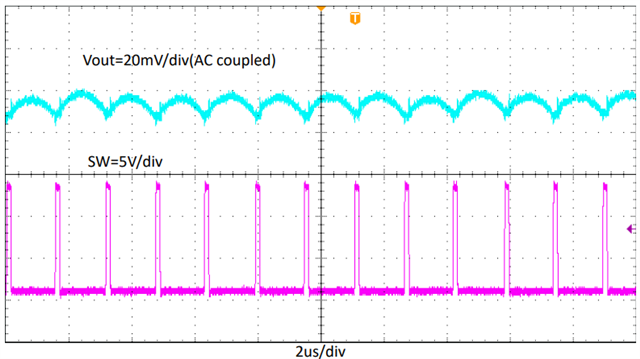Other Parts Discussed in Thread: TPS564247
Nowadays, ECO mode and FCCM mode are the most popular 2 operation mode of a buck converter. This FAQ will make a sample explanation about this operation mode, help user make a proper decision when selecting a buck converter IC.
Actually, the main difference is at light-load behavior.
ECO mode is also called PSM (Pulse skip mode) sometimes. But the behavior is the same, which means the device will reduce its switching frequency to be lower than its normal full-load switching frequency by skipping pulse. By reducing the light-load switching frequency, the switching loss will reduced and the light-load efficiency will be better. But the output ripple will be larger.
FCCM means force continues conducting mode. For FCCM device, its steady state switching frequency is always the same. In light load its switching frequency is same higher as that in full-load, which can achieve low output ripple compare with ECO mode. But the disadvantage is that its light load efficiency is lower than ECO mode, because of higher switching frequency, high switching loss of MOSFET.
Following is the example how to select ECO mode and FCCM device of one product family.
TPS565242 is one ECO mode buck converter IC with SOT-563 package, which can support 16V input voltage, 5A output current and 600KHz normal switching frequency.
TPS564247 is one FCCM mode buck converter IC with SOT-563 package, which can support 16V input voltage, 5A output current and 600KHz normal switching frequency.
If user prefer high light-load efficiency, ECO-mode TPS565242 is a good choice; if user has a high requirement of output ripple and light-load efficiency isn't big concern, FCCM TPS564247 is suggested.
Fig. 1 is the efficiency curve of TPS565242- ECO mode device; Fig. 2 is the efficiency curve of TPS565247- FCCM mode device; Fig. 3 is the output ripple of TPS565242- ECO mode device; Fig. 4 is the output ripple of TPS565247- FCCM mode device with the same inductor and output capacitor.

Fig.1 Efficiency curve of TPS565242- ECO mode device

Fig.2 Efficiency curve of TPS565247- FCCM mode device

Fig.3 Output ripple of TPS565247- FCCM mode device at 0.01A load

Fig.4 Output ripple of TPS565247- FCCM mode device at 0.01A load

